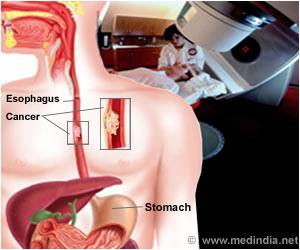In the past few years, a number of anti-cancer drugs have been developed which are directed selectively against specific key molecules of tumor cells.
In the past few years, a number of anti-cancer drugs have been developed which are directed selectively against specific key molecules of tumor cells. Among these is an antibody called cetuximab, which attaches to a protein molecule that is found in large amounts on the surface of many types of cancer cells. When this surface molecule, called epidermal growth factor receptor, or EGF-R for short, is blocked by cetuximab, the cancer cell receives less signals stimulating cell division.
Clinical studies of non-small cell lung cancer, which is the most frequent type of lung cancer, have shown so far that only part of the patients treated with cetuximab benefit from the treatment. Therefore, doctors are urgently searching for biomarkers which reliably predict responsiveness to the antibody therapy.Professor Heike Allgayer heads the Department of Experimental Surgery of the Mannheim Medical Faculty of the University of Heidelberg and the Clinical Cooperation Unit "Molecular Oncology of Solid Tumors" at DKFZ. The scientist suspects that the therapeutic antibody can disarm, in particular, individual cancer cells that have detached from the primary tumor, invade other tissues and grow into secondary tumors there. Therefore, Allgayer and her team focused on lung cancer cells' ability to metastasize. Indeed, the investigators were the first to show in lung cancer cell lines that cetuximab inhibits growth and invasion of cancer cells and reduces the frequency of metastasis.
For invading surrounding healthy tissue, cancer cells needs specific proteins which act like molecular scissors to cut a trail for them. One of these cutting tools is the u-PAR protein which is considered a marker molecule for the invasion ability of cancer cells. Allgayer's team found out that cancer cells produce less u-PAR after treatment with cetuximab: The antibody appears to block the cell's u-PAR production.
Allgayer's team also showed that non-small cell lung cancer is resistant to cetuximab treatment, in particular, when the cancer cells produce large amounts of u-PAR. When the researchers switched off u-PAR production using a genetic trick, the cells responded to cetuximab again.
"Our results show, for the first time, that u-PAR might be an indicator of the effectiveness of cetuximab treatment in non-small cell lung cancer," Heike Allgayer says. "The more u-PAR the cells produce, the less they are responsive to the drug." This conclusion is in line with first observations made in lung cancer patients. Tumor cells of patients who did not respond to cetuximab usually produced higher amounts of the molecular scissors u-PAR.
It came as a surprise for Allgayer that EGF-R itself, the target molecule of the drug cetuximab, did not correlate with responsiveness. Further investigations are needed to verify these results. "We want to find possibilities to prescribe the drug only for those patients who can actually benefit from it," says Allgayer, a doctor and scientist. "Finding suitable biomarkers is one of the most urgent tasks when introducing novel, target-specific therapeutics."
SRM













